SEO
A 6-Step Guide on How to Get SEO Clients
Whether you’re an established SEO agency or a freelancer just starting out, leads are the lifeblood of your business.
To generate new, relevant leads and clients, you need a system that you can implement and improve over time. And we’ll help you do exactly that.
In this article, you’ll learn the definition of an SEO lead and the six steps to getting great leads.
An SEO lead is a potential client who has expressed an interest in your SEO services. They either find you first and get in touch, or you proactively reach out to them and offer your services.
And here’s how you get them.
The first step is creating or providing a tailored SEO service for particular industries. These services can range from offering SEO consultations with a minimal monthly retainer to serving a specific niche (e.g., lawyers).
When I first pivoted from web design to SEO, I made the mistake of trying to offer a full SEO service.
Then at the time, Ryan Stewart said in a podcast to be great at keyword research and sell it to agencies.
So I did.
Looking around the SEO industry, you’ll find people and agencies doing well by specializing in a particular service or niche.
Look at Rankings.io, which specializes in law firm SEO. Or check out Full Stadium, which specializes in the accounting firm sector.

You can go even narrower. For example, Haro SEO builds links for clients from the Help A Reporter Out website. In other words, it caters to a niche within a niche (link building/digital PR).

Hence, you can consider niche SEO services such as keyword research, SEO strategy, on-page, off-page, technical SEO, content, YouTube SEO, or local SEO.
Once you’ve defined your target industry and services, there are two ways to find prospects: inbound and outbound marketing.
Inbound
Inbound is where prospects come to you instead of you reaching out to them. Let’s run through the most popular inbound marketing channels that generate leads.
Website
Provided you have a website, you can use it to generate leads if you make people aware of your SEO services and encourage them to take action by either calling you, sending you an email, or downloading an incentive.
Look at this landing page that explains and communicates the growth benefits of the company’s SEO services. The page also includes a strong call to action: get an SEO quote today.

SEO
You already know that organic traffic is the main traffic source for many websites.
Use Ahrefs’ Keywords Explorer to identify the relevant keywords your prospects are searching for and assess the potential of that traffic.
- Type “SEO” and select your country
- Use the Include filter to enter the industry or niche you are targeting, e.g., accountants, contractors
You can see the Keyword Difficulty (KD), search volume, global volume, and Traffic Potential (TP) metrics.

Now select the “SERP” button to view the traffic to the top pages.

Next, create a landing page targeting this topic, outlining what you offer and how to get in touch.
PPC
You can drive traffic quickly if you need leads urgently using Google Ads.
You can see this agency’s Google Ad campaigns and the keywords they target using the new paid search feature within Ahrefs’ Site Explorer.

Groups and communities
My path into SEO was via traditional marketing and web design.
As a member of an Adobe web design forum, I generated leads from other web design agencies that didn’t have an interest in or resources for SEO.
Also, the Ahrefs Insider group regularly runs SEO Speed Dating, where members are free to post jobs or projects they need help with—great for lead generation.

And agencies that use Ahrefs can apply to be featured on our SEO directory and generate interest in their services.

Building your reputation
You can build a reputation for your services by blogging, using social media, or appearing on podcasts.
With some hard work, I grew my organic traffic to several thousand monthly visits. I then used email marketing to offer my services and training courses for opted-in subscribers.
Email marketing
I’m fortunate enough to have built up an email list of opted-in subscribers and prospects. But before that, I simply went through my email account and found the email address of every contact I knew.
I added them to ConvertKit as a segment and emailed them regularly with useful SEO guides.

Social media
Samuel Schmitt builds his social reputation using Twitter and LinkedIn.
On LinkedIn, Samuel posts various resources, such as article links and videos, as well as comments and likes content from people in his network.

Podcasts and videos
George Chasiotis is the managing director of Minuttia, a SaaS SEO agency. He has built up his reputation as an expert in semantic SEO and topical authority.
I first listened to George on the SEO Rant Podcast and heard him again talking about topical authority with a partner on YouTube.

Events and conferences
You can attend many SEO conferences to network with others in the industry and build connections and potential business.
But do events and conferences exist if you want to connect with clients directly?
The SEO Works in Sheffield joined its Chamber of Commerce as a patron member (like a sponsor).
For £10K, it gets:
- Featured in fortnightly newsletters to other Chamber members.
- Advertising space in Chamber magazine.
- Dedicated email to the business database four times per year.
- Displayed on the Chamber website.
- Promoted socially.
- Invited to networking events.
- To host its workshops for Chamber members.
If this type of membership is beyond your budget, you can identify web design meetups in your area.
For example, there are various web design meetups in my area.

If I attend these meetups, I’ll casually drop into conversations I do SEO; perhaps, I’ll find a few connections.
Word of mouth and referrals
Word of mouth refers to recommendations from friends and family, and it can be powerful when it comes to increasing sales.
For instance, I get most of my referrals from my accountant, who referred every one of his clients to me after lockdown.
I gave them a simple audit that compared their website with a competitor’s to “open a dialogue” with them.
Then I scheduled phone calls to discuss ways to prioritize revenue opportunities from SEO-related work.
Now onto outbound.
Outbound
Outbound is when companies send messages to potential customers rather than wait for them to come looking for their services. This can be through email, direct mail, telephone, etc.
Sidenote.
Check legislation in your state or country before doing cold email outreach.
You can find prospects to target using Ahrefs’ Content Explorer.
Let’s say I want to target insolvency practitioners in the U.K.
- Enter
insolvency practitioner site:co.ukand select “In title” - Filter “One page per domain” and “no subdomains”
And now, I have around 249 unique websites.

You can change “insolvency practitioner” to the type of company you are targeting.
Do also change site:co.uk to the country you wish to target, e.g., site:ca for Canada.
If you’re targeting prospects in the U.S., enter the business type and location into Content Explorer, e.g., Certified Public Accountant OR CPA AND Houston.
Now that you have found prospects to target, the next step is to qualify prospects or leads.
Lead qualification is the process of determining which leads are most likely to become great customers and focus on them first.
Inbound and outbound leads are qualified differently.
Inbound qualification
Your website will be the primary channel to get qualified leads, and you can do this by including an inquiry form to sort the wheat from the chaff.
Include a form on your website that collects the following prospect information:
- What you are looking for
- What you are investing
- When you’re looking to start
- Name, email, URL, and telephone
In this example, here are the three questions a visitor is asked.
Question 1. What help do you need?

Question 2. What is your budget?

Question 3. When are you looking to start?

If the prospect is a highly qualified lead, they are invited to book a call.

A less-qualified lead can sign up for a newsletter.

If you’re using SEO or PPC, a form or call to action should ideally be located above the fold of the browser on your landing pages. The following examples are from the website of another Ahrefs blog contributor, Sam Underwood:

Outbound qualification
You must gather information beyond their niche and company name to qualify an outbound prospect.
A Content Explorer report contains metrics such as Domain Rating (DR), referring domains, website traffic, and website traffic value. That’s valuable data to include in your outreach.
1. Export list from Content Explorer into Google Sheets
Following on from step #2 above, here’s an example of the report exported from Content Explorer into Google Sheets:

2. Clean up the spreadsheet
Remove irrelevant websites and all the columns, except for the content title, URL, referring domains, and website traffic.

3. Export CSV and import into Hunter or Mailshake
Now select File > Download > CSV.
4. Find and verify contact
I’ll use Hunter in this example, but you can use any email outreach software.
https://www.youtube.com/watch?v=GE0YFMZknTM
Set up custom attributes to import the Website Traffic and Referring Domains data from your spreadsheet.

Go to Bulks > Bulk Domain Search > New Bulk.

Select Domain Search > New Bulk > Name your list and follow the screenshot for setup instructions.

Preview your list, press “Launch,” and Hunter will find and verify the email addresses of prospects.

5. Create a campaign with two outreach emails
Now go to Campaigns and create a new campaign.

Below is an example of a sales outreach email. Also, try to follow these four email outreach guidelines:
- Write a subject line to encourage the prospect to open the email
- Personalize the email with their first name
- Offer something of value, e.g., the email below contains a quick comparison of their website traffic with a competitor’s
- Include a call to action

Then write a follow-up email:

You can use Calendly or Google Calendar to allow prospects to book a discovery call with you.
Here’s a video outlining how to schedule appointments on Google Calendar:
https://www.youtube.com/watch?v=7AsmRNiveGc

- Now add your recipients
- Select “From Leads”
- Select the list you created from the left menu and add the recipients to your campaign
- Press “Next,” and you’ll see a preview of every email
- Press “Launch” when you’re ready to start your outreach campaign

The purpose of the scheduled appointment is to see if there is a fit between you and your potential customer.
During the call, they’ll want to learn more about your experience, track record, processes, and team.
If they are an inbound lead, you already know they want a rough idea of the budget and start date from the form they filled in.
If they are an outbound lead, you already know their organic traffic and how it stacks up with a competitor’s.
You’ll want to discuss the service they want, budget, and timing. Also, it’s important to determine their future state.
You’ll discuss how you measure success.
You’ll provide pricing guidance, i.e., how you work and charge.
Subsequent meetings and dialogues revolve around the same topics.
Tell me more about your situation
I called a lead, Sam, at the appointed time and asked about his business.
He told me he was paying for leads from others, but he had an excellent offline network and social profile.
I told him a story about an ex-client who had purchased non-exclusive leads. The ex-client then called up prospects who had already received 10 calls from other contractors. Apparently, those contractors had been sold the same leads.
He asked about me.
I explained my business model and provided my traffic and conversion rates.
I proceeded to tell him he would want his own leads rather than purchasing third-party leads.
The bridge
Then to bridge the connection between his business and my business, I said:
“If a competing website gets 1,000 visits—let’s say they convert 2% into inquiries. That’s 20 inquiries a month. How many inquiries do you typically convert into a paid project?”
“10%,” he said.
“So two jobs at £20K are £40K a month or £480K a year,” I said.
“Yes, broadly speaking,” Sam replied.
Where do we go from here?
I sensed the call was nearing an end, so I asked, “Where do you want to go from here?”
P.S. This is my favorite call to action at the end of a call or email.
Sam said he would email me the plans for his business as we advance, and we should speak soon.
He texted me that evening.
One of the biggest mistakes I’ve made is to invest my time writing up a proposal and price only for the prospect to say no or, worse, not return my email or call.
So when asked, you should say a price before writing a proposal.
If they insist on a written proposal, try to resist and provide them with a price range.
Here’s an example: Bill, this project will range from $3,000 to $5,000 to start with, then a few $$$$ per month. Is that in alignment with your budget?
Unpaid proposals you send should fit on one page and include:
- Where they are now versus their future state.
- Pricing options anchored against each other.
When you give a client one pricing option, there are only two outcomes: yes or no. And a “no” outcome results in the prospect comparing your price with a competitor’s.
But when you provide pricing options, the client is now faced with Option A, Option B, or no.
For example, my goal is for the client to buy Option A. When I position the higher anchor price (Option B) alongside it, the client can now compare both my options.
According to Blair Enns, when offered two pricing options, a client will choose Option B 50% of the time.
Here’s a pricing example of a one-off project:
| Option A | Option B |
|---|---|
| – Keyword research – Produce 10 content briefs |
– Keyword research – Produce 10 content briefs – Professional copywriting for 10 pages – Publish 10 optimized pages |
| $1,999 | $7,999 |
Here’s a pricing example of an SEO monthly retainer:
| SEO Option A | SEO Option B |
|---|---|
| – Keyword research – Produce 10 content briefs per month – Copywriting for 10 pages – Publish 10 optimized pages – 1x outreach campaign per month |
– Keyword research – Produce 10 content briefs per month – Copywriting for 10 pages – Publish 10 optimized pages – 1x outreach campaign per month |
| $5,000 per month | $50,000 per annum paid in two installments |
Once they’ve verbally confirmed they want to go ahead, you can send them a copy created from our free SEO contract template.
This template includes 13 essential sections that help you protect yourself and set clear client expectations.
You can customize it however you want. Just change the names, edit the price and service descriptions, and adjust the sample terms and conditions to suit your needs.
Final thoughts
When you’re starting out, focus on outbound activity to generate sales leads. Those with an established SEO track record have a different problem: They need to filter inbound leads to maximize their revenues and margins.
Tailor your SEO service for your target industry, find prospects, qualify them, set up a discovery phone call, and give them a price before committing to writing a proposal.
Finally, use our SEO contract template to close the deal.
Got questions? Ping me on Twitter.
SEO
How To Use ChatGPT For Keyword Research

Anyone not using ChatGPT for keyword research is missing a trick.
You can save time and understand an entire topic in seconds instead of hours.
In this article, I outline my most effective ChatGPT prompts for keyword research and teach you how I put them together so that you, too, can take, edit, and enhance them even further.
But before we jump into the prompts, I want to emphasize that you shouldn’t replace keyword research tools or disregard traditional keyword research methods.
ChatGPT can make mistakes. It can even create new keywords if you give it the right prompt. For example, I asked it to provide me with a unique keyword for the topic “SEO” that had never been searched before.
“Interstellar Internet SEO: Optimizing content for the theoretical concept of an interstellar internet, considering the challenges of space-time and interplanetary communication delays.”
Although I want to jump into my LinkedIn profile and update my title to “Interstellar Internet SEO Consultant,” unfortunately, no one has searched that (and they probably never will)!
You must not blindly rely on the data you get back from ChatGPT.
What you can rely on ChatGPT for is the topic ideation stage of keyword research and inspiration.
ChatGPT is a large language model trained with massive amounts of data to accurately predict what word will come next in a sentence. However, it does not know how to do keyword research yet.
Instead, think of ChatGPT as having an expert on any topic armed with the information if you ask it the right question.
In this guide, that is exactly what I aim to teach you how to do – the most essential prompts you need to know when performing topical keyword research.
Best ChatGPT Keyword Research Prompts
The following ChatGPT keyword research prompts can be used on any niche, even a topic to which you are brand new.
For this demonstration, let’s use the topic of “SEO” to demonstrate these prompts.
Generating Keyword Ideas Based On A Topic
What Are The {X} Most Popular Sub-topics Related To {Topic}?
The first prompt is to give you an idea of the niche.
As shown above, ChatGPT did a great job understanding and breaking down SEO into three pillars: on-page, off-page & technical.
The key to the following prompt is to take one of the topics ChatGPT has given and query the sub-topics.
What Are The {X} Most Popular Sub-topics Related To {Sub-topic}?
For this example, let’s query, “What are the most popular sub-topics related to keyword research?”
Having done keyword research for over 10 years, I would expect it to output information related to keyword research metrics, the types of keywords, and intent.
Let’s see.
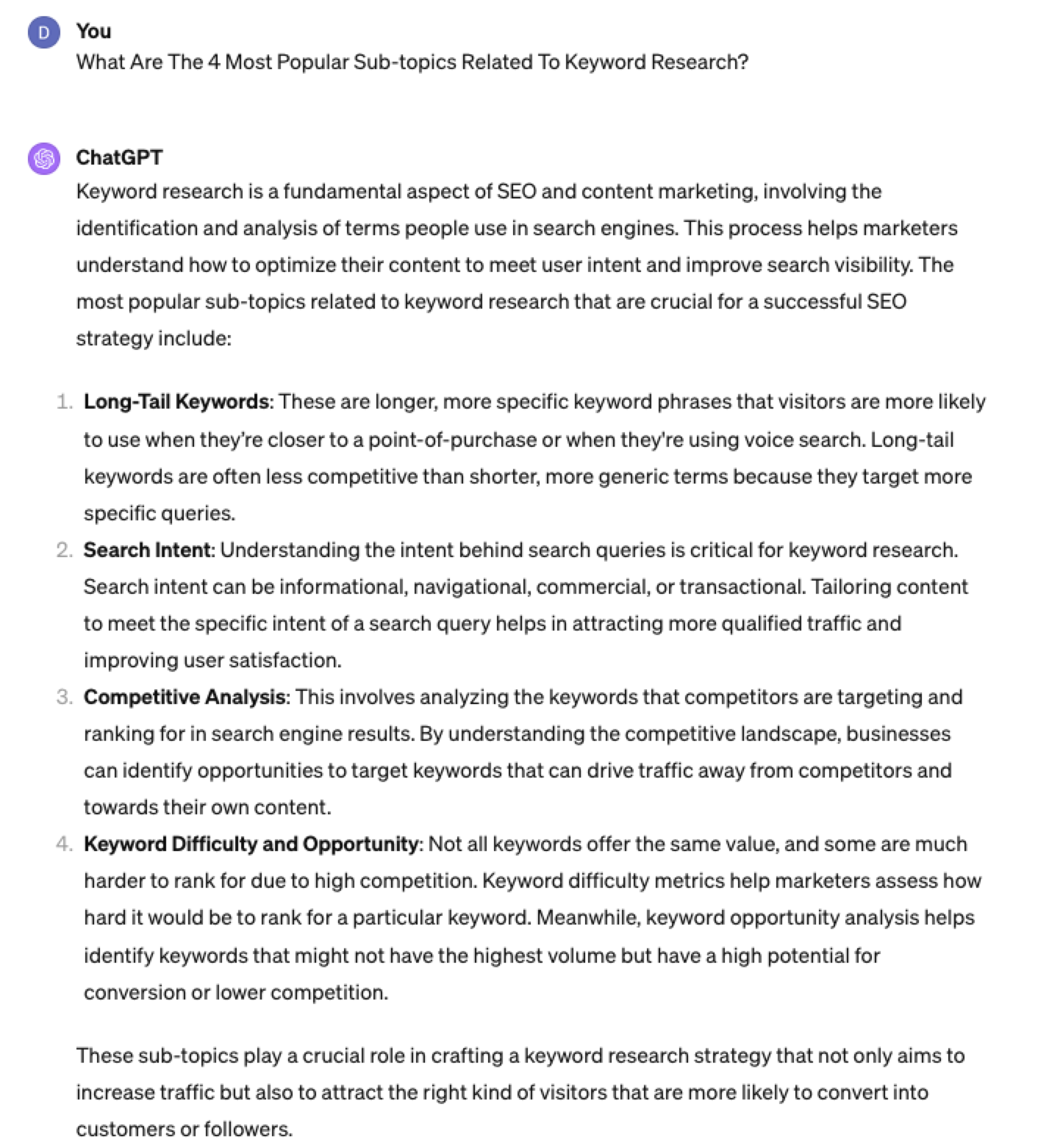 Screenshot from ChatGPT 4, April 2024
Screenshot from ChatGPT 4, April 2024Again, right on the money.
To get the keywords you want without having ChatGPT describe each answer, use the prompt “list without description.”
Here is an example of that.
List Without Description The Top {X} Most Popular Keywords For The Topic Of {X}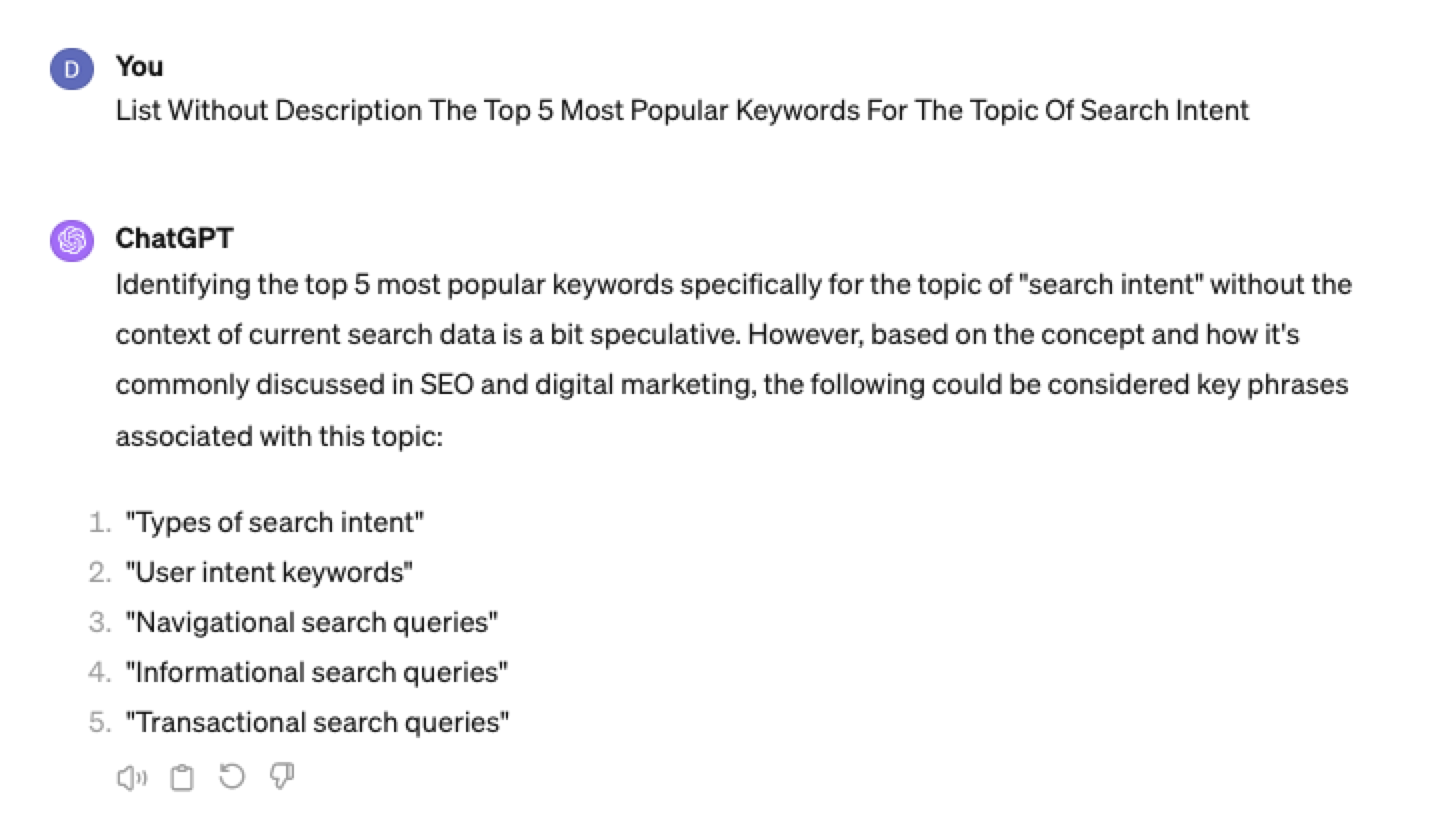
You can even branch these keywords out further into their long-tail.
Example prompt:
List Without Description The Top {X} Most Popular Long-tail Keywords For The Topic “{X}”
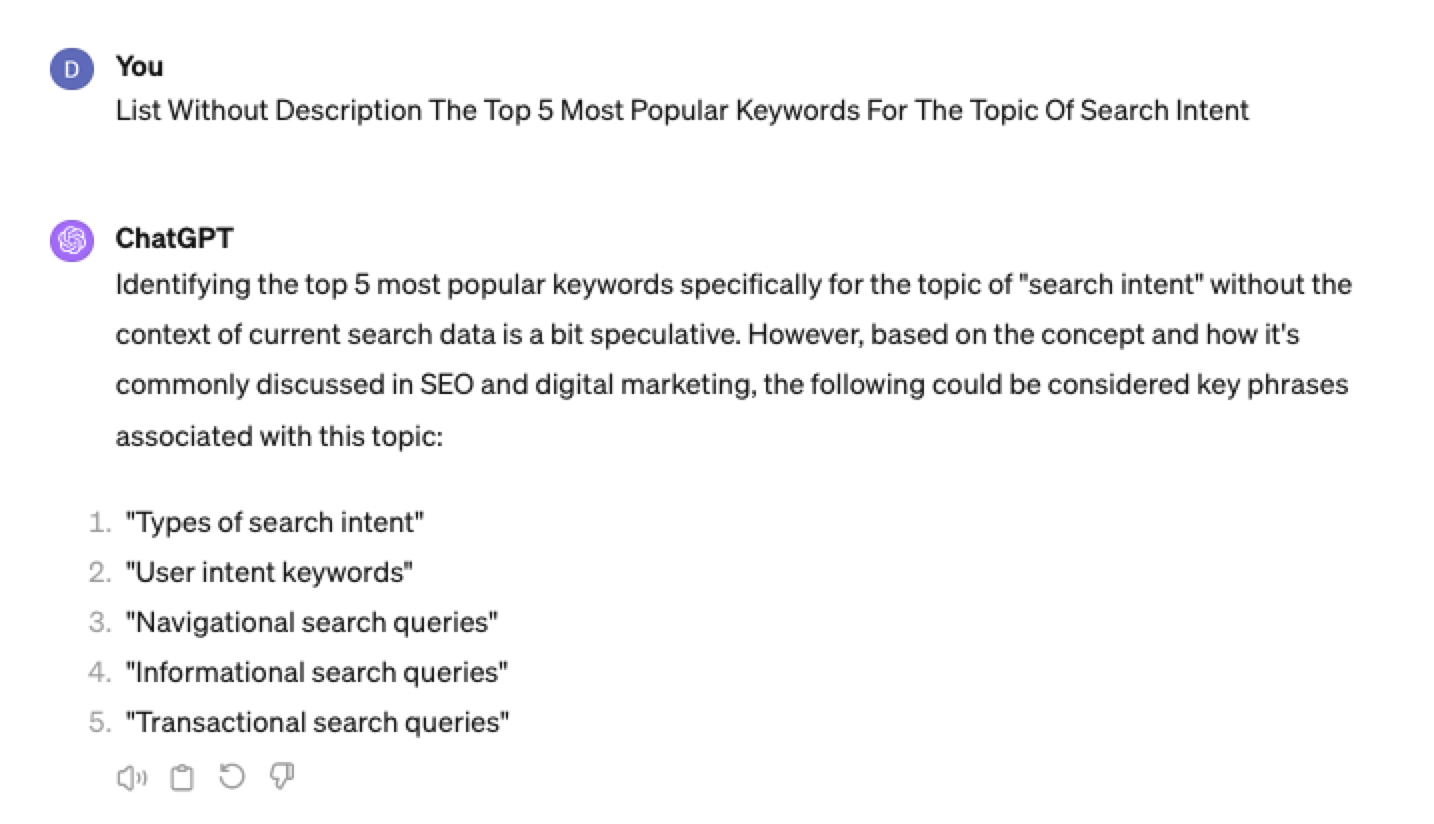 Screenshot ChatGPT 4,April 2024
Screenshot ChatGPT 4,April 2024List Without Description The Top Semantically Related Keywords And Entities For The Topic {X}
You can even ask ChatGPT what any topic’s semantically related keywords and entities are!
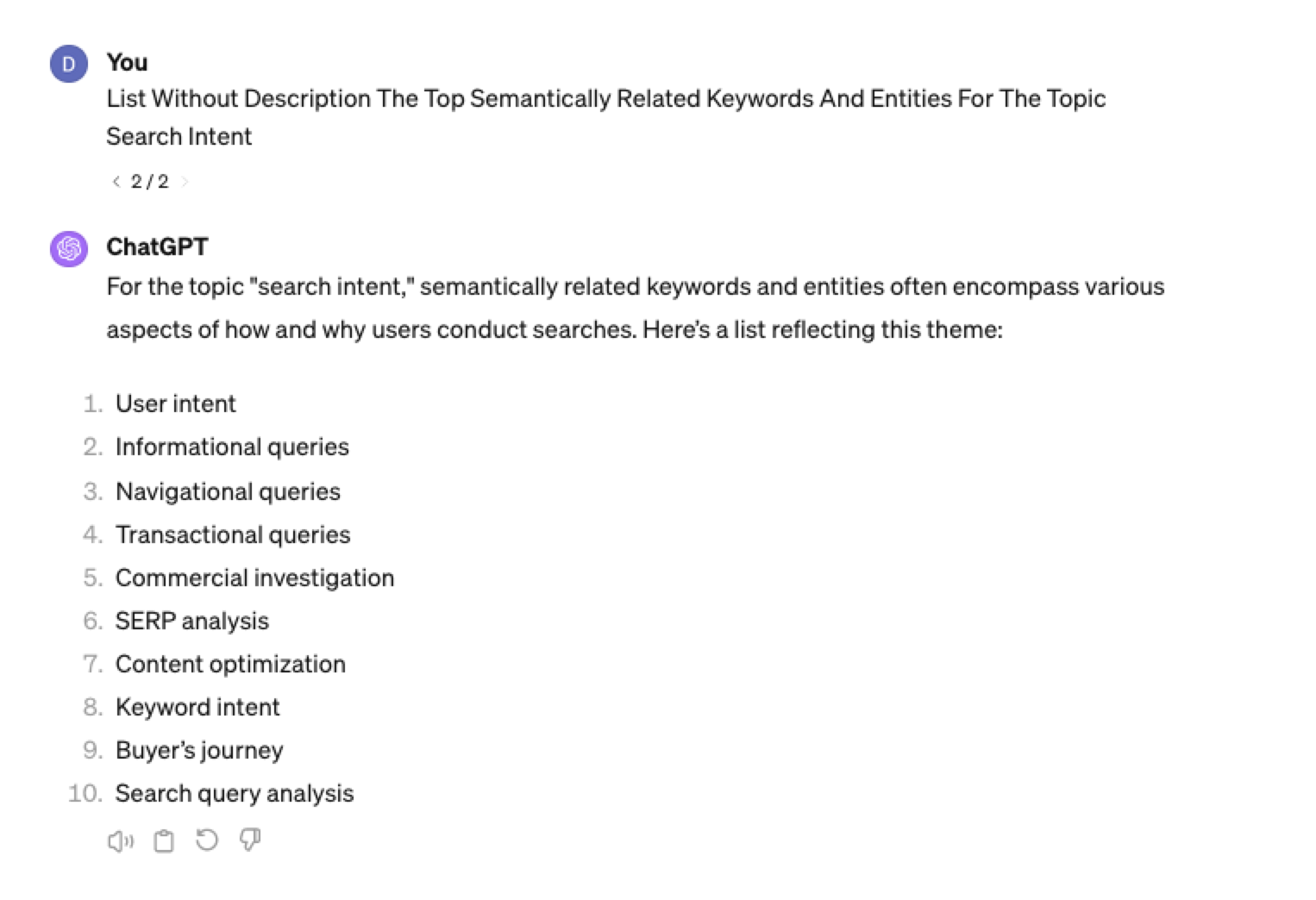 Screenshot ChatGPT 4, April 2024
Screenshot ChatGPT 4, April 2024Tip: The Onion Method Of Prompting ChatGPT
When you are happy with a series of prompts, add them all to one prompt. For example, so far in this article, we have asked ChatGPT the following:
- What are the four most popular sub-topics related to SEO?
- What are the four most popular sub-topics related to keyword research
- List without description the top five most popular keywords for “keyword intent”?
- List without description the top five most popular long-tail keywords for the topic “keyword intent types”?
- List without description the top semantically related keywords and entities for the topic “types of keyword intent in SEO.”
Combine all five into one prompt by telling ChatGPT to perform a series of steps. Example:
“Perform the following steps in a consecutive order Step 1, Step 2, Step 3, Step 4, and Step 5”
Example:
“Perform the following steps in a consecutive order Step 1, Step 2, Step 3, Step 4 and Step 5. Step 1 – Generate an answer for the 3 most popular sub-topics related to {Topic}?. Step 2 – Generate 3 of the most popular sub-topics related to each answer. Step 3 – Take those answers and list without description their top 3 most popular keywords. Step 4 – For the answers given of their most popular keywords, provide 3 long-tail keywords. Step 5 – for each long-tail keyword offered in the response, a list without descriptions 3 of their top semantically related keywords and entities.”
Generating Keyword Ideas Based On A Question
Taking the steps approach from above, we can get ChatGPT to help streamline getting keyword ideas based on a question. For example, let’s ask, “What is SEO?”
“Perform the following steps in a consecutive order Step 1, Step 2, Step 3, and Step 4. Step 1 Generate 10 questions about “{Question}”?. Step 2 – Generate 5 more questions about “{Question}” that do not repeat the above. Step 3 – Generate 5 more questions about “{Question}” that do not repeat the above. Step 4 – Based on the above Steps 1,2,3 suggest a final list of questions avoiding duplicates or semantically similar questions.”
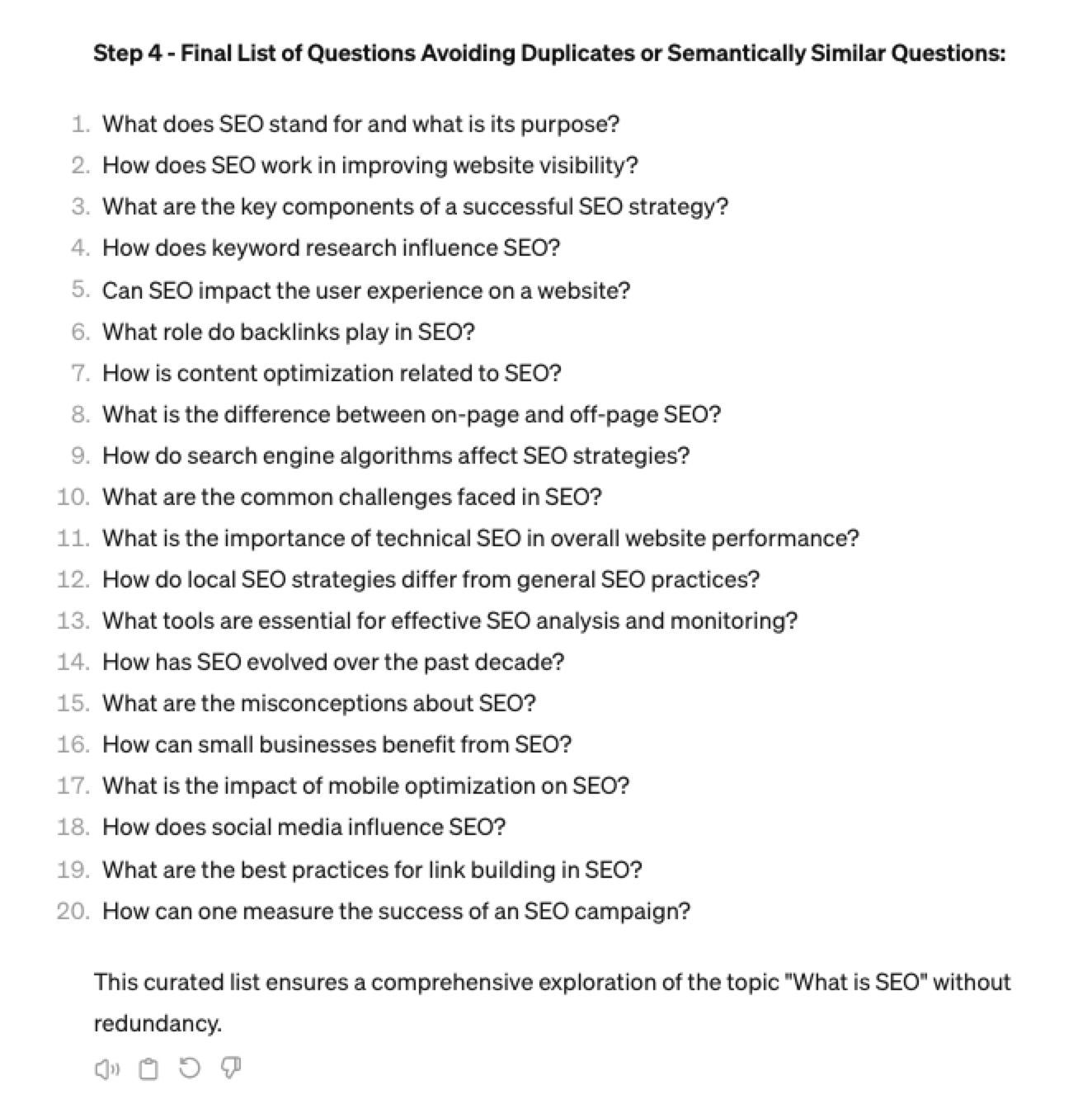 Screenshot ChatGPT 4, April 2024
Screenshot ChatGPT 4, April 2024Generating Keyword Ideas Using ChatGPT Based On The Alphabet Soup Method
One of my favorite methods, manually, without even using a keyword research tool, is to generate keyword research ideas from Google autocomplete, going from A to Z.
-
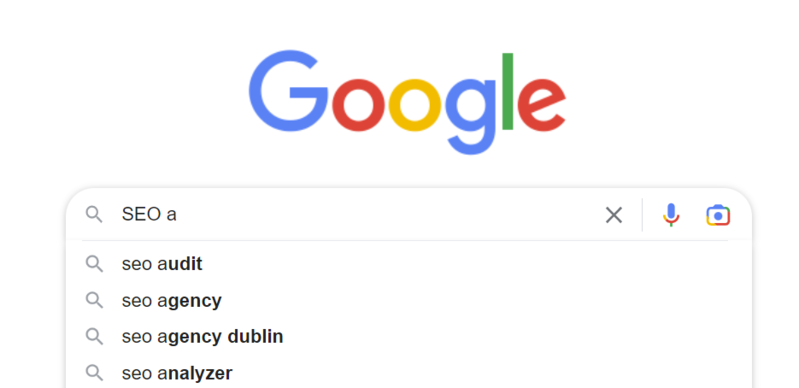 Screenshot from Google autocomplete, April 2024
Screenshot from Google autocomplete, April 2024
You can also do this using ChatGPT.
Example prompt:
“give me popular keywords that includes the keyword “SEO”, and the next letter of the word starts with a”
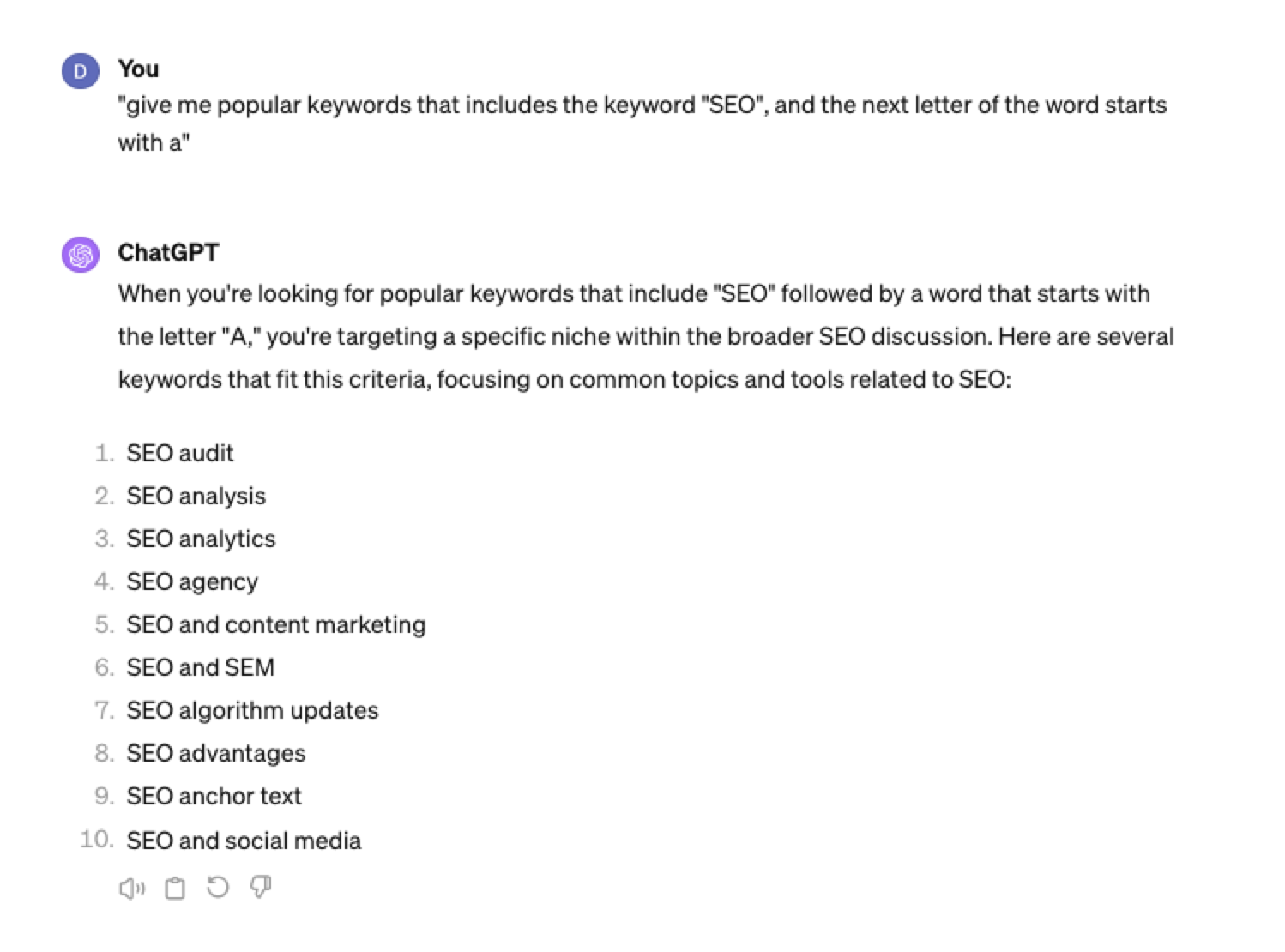 Screenshot from ChatGPT 4, April 2024
Screenshot from ChatGPT 4, April 2024Tip: Using the onion prompting method above, we can combine all this in one prompt.
“Give me five popular keywords that include “SEO” in the word, and the following letter starts with a. Once the answer has been done, move on to giving five more popular keywords that include “SEO” for each letter of the alphabet b to z.”
Generating Keyword Ideas Based On User Personas
When it comes to keyword research, understanding user personas is essential for understanding your target audience and keeping your keyword research focused and targeted. ChatGPT may help you get an initial understanding of customer personas.
Example prompt:
“For the topic of “{Topic}” list 10 keywords each for the different types of user personas”
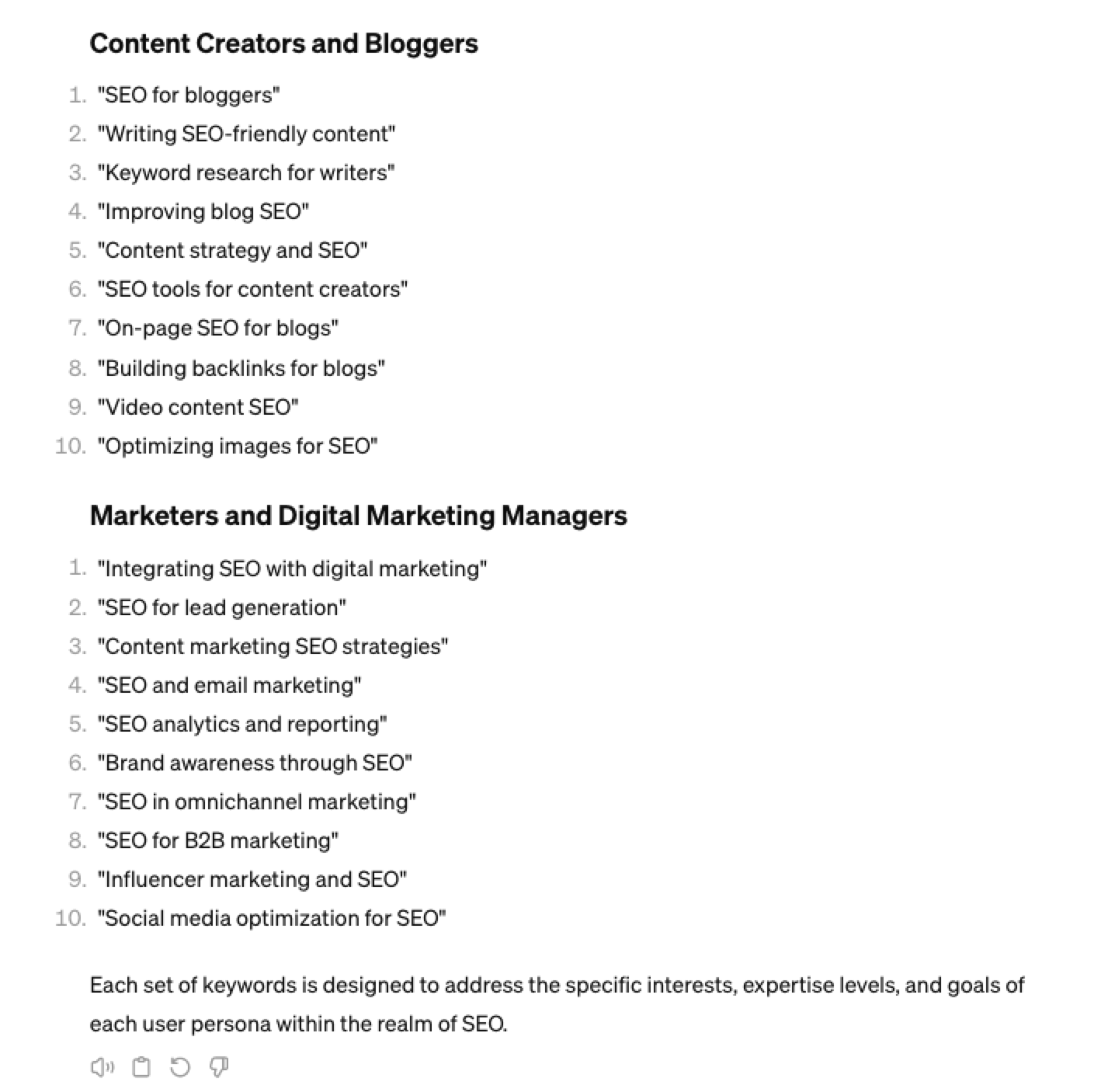 Screenshot from ChatGPT 4, April 2024
Screenshot from ChatGPT 4, April 2024You could even go a step further and ask for questions based on those topics that those specific user personas may be searching for:
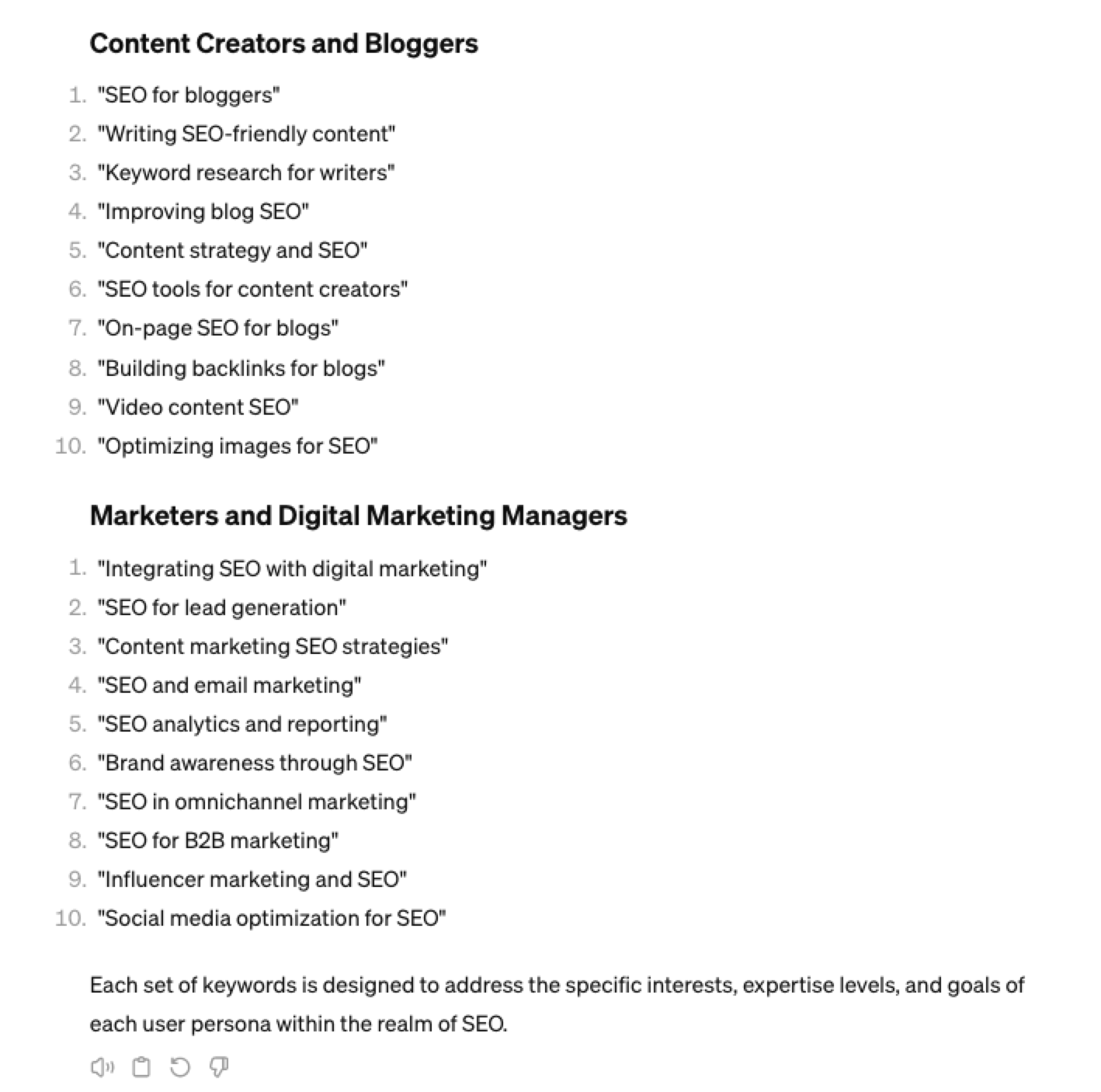 Screenshot ChatGPT 4, April 2024
Screenshot ChatGPT 4, April 2024As well as get the keywords to target based on those questions:
“For each question listed above for each persona, list the keywords, as well as the long-tail keywords to target, and put them in a table”
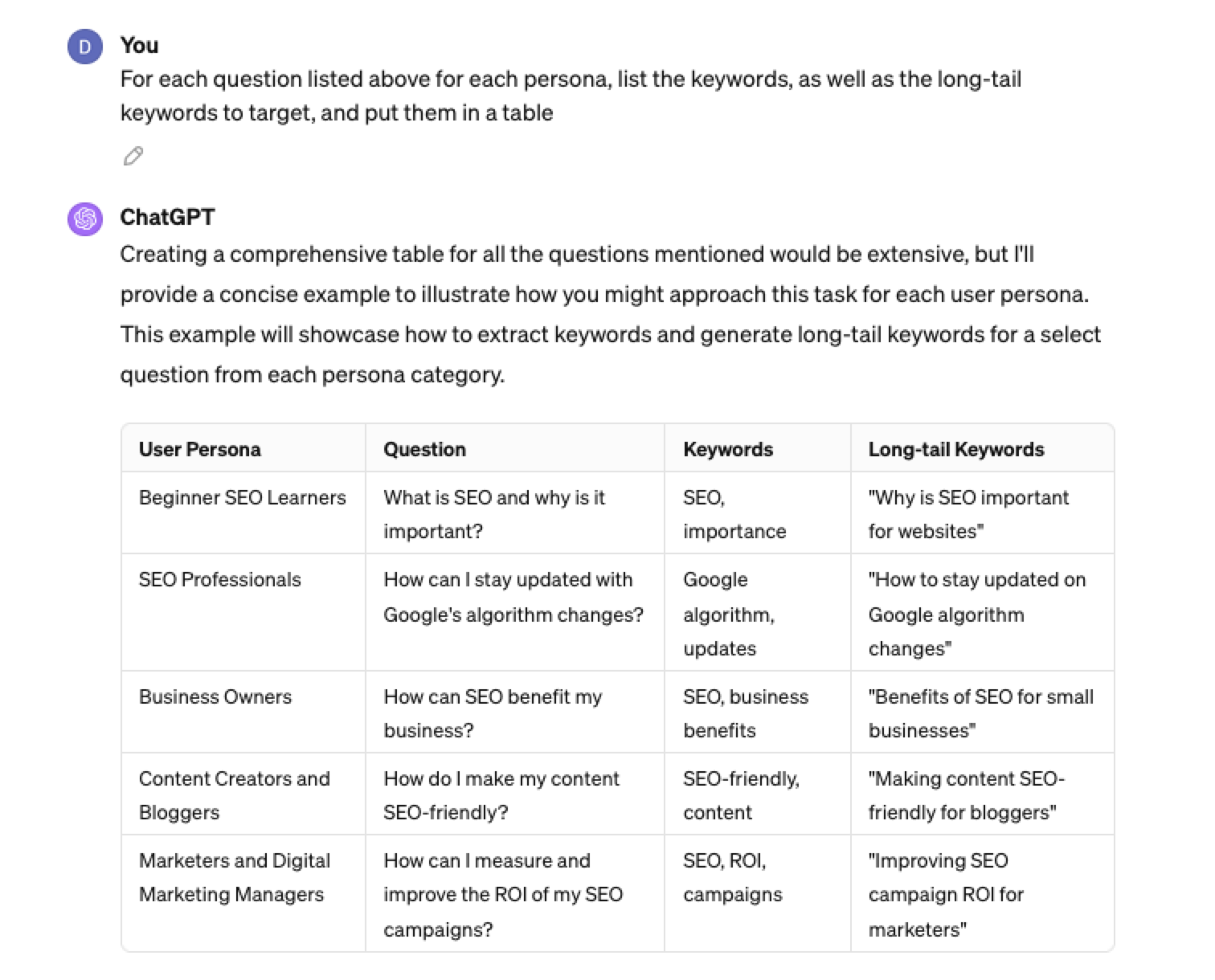 Screenshot from ChatGPT 4, April 2024
Screenshot from ChatGPT 4, April 2024Generating Keyword Ideas Using ChatGPT Based On Searcher Intent And User Personas
Understanding the keywords your target persona may be searching is the first step to effective keyword research. The next step is to understand the search intent behind those keywords and which content format may work best.
For example, a business owner who is new to SEO or has just heard about it may be searching for “what is SEO.”
However, if they are further down the funnel and in the navigational stage, they may search for “top SEO firms.”
You can query ChatGPT to inspire you here based on any topic and your target user persona.
SEO Example:
“For the topic of “{Topic}” list 10 keywords each for the different types of searcher intent that a {Target Persona} would be searching for”
ChatGPT For Keyword Research Admin
Here is how you can best use ChatGPT for keyword research admin tasks.
Using ChatGPT As A Keyword Categorization Tool
One of the use cases for using ChatGPT is for keyword categorization.
In the past, I would have had to devise spreadsheet formulas to categorize keywords or even spend hours filtering and manually categorizing keywords.
ChatGPT can be a great companion for running a short version of this for you.
Let’s say you have done keyword research in a keyword research tool, have a list of keywords, and want to categorize them.
You could use the following prompt:
“Filter the below list of keywords into categories, target persona, searcher intent, search volume and add information to a six-column table: List of keywords – [LIST OF KEYWORDS], Keyword Search Volume [SEARCH VOLUMES] and Keyword Difficulties [KEYWORD DIFFICUTIES].”
-
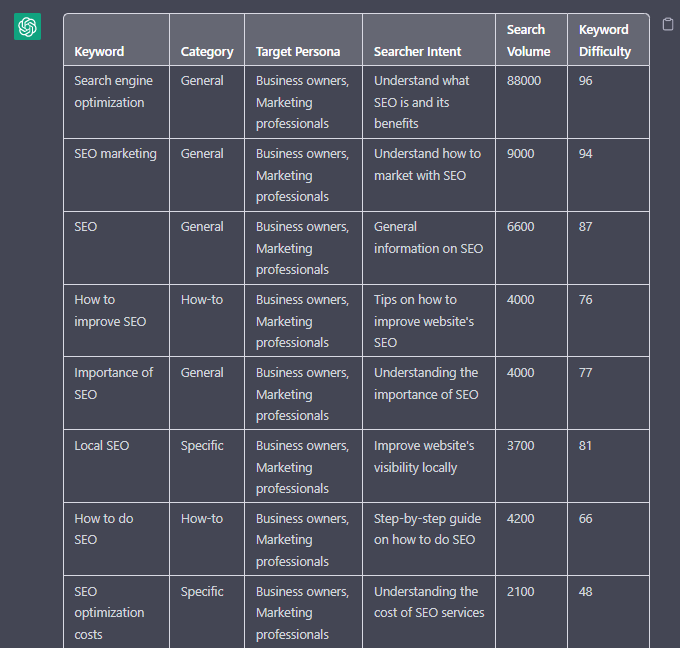 Screenshot from ChatGPT, April 2024
Screenshot from ChatGPT, April 2024
Tip: Add keyword metrics from the keyword research tools, as using the search volumes that a ChatGPT prompt may give you will be wildly inaccurate at best.
Using ChatGPT For Keyword Clustering
Another of ChatGPT’s use cases for keyword research is to help you cluster. Many keywords have the same intent, and by grouping related keywords, you may find that one piece of content can often target multiple keywords at once.
However, be careful not to rely only on LLM data for clustering. What ChatGPT may cluster as a similar keyword, the SERP or the user may not agree with. But it is a good starting point.
The big downside of using ChatGPT for keyword clustering is actually the amount of keyword data you can cluster based on the memory limits.
So, you may find a keyword clustering tool or script that is better for large keyword clustering tasks. But for small amounts of keywords, ChatGPT is actually quite good.
A great use small keyword clustering use case using ChatGPT is for grouping People Also Ask (PAA) questions.
Use the following prompt to group keywords based on their semantic relationships. For example:
“Organize the following keywords into groups based on their semantic relationships, and give a short name to each group: [LIST OF PAA], create a two-column table where each keyword sits on its own row.
-
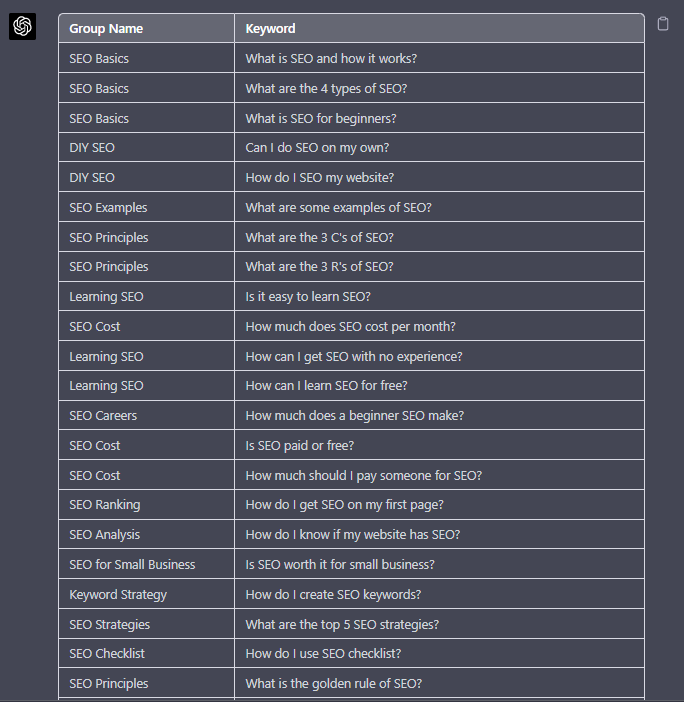 Screenshot from ChatGPT, April 2024
Screenshot from ChatGPT, April 2024
Using Chat GPT For Keyword Expansion By Patterns
One of my favorite methods of doing keyword research is pattern spotting.
Most seed keywords have a variable that can expand your target keywords.
Here are a few examples of patterns:
1. Question Patterns
(who, what, where, why, how, are, can, do, does, will)
“Generate [X] keywords for the topic “[Topic]” that contain any or all of the following “who, what, where, why, how, are, can, do, does, will”
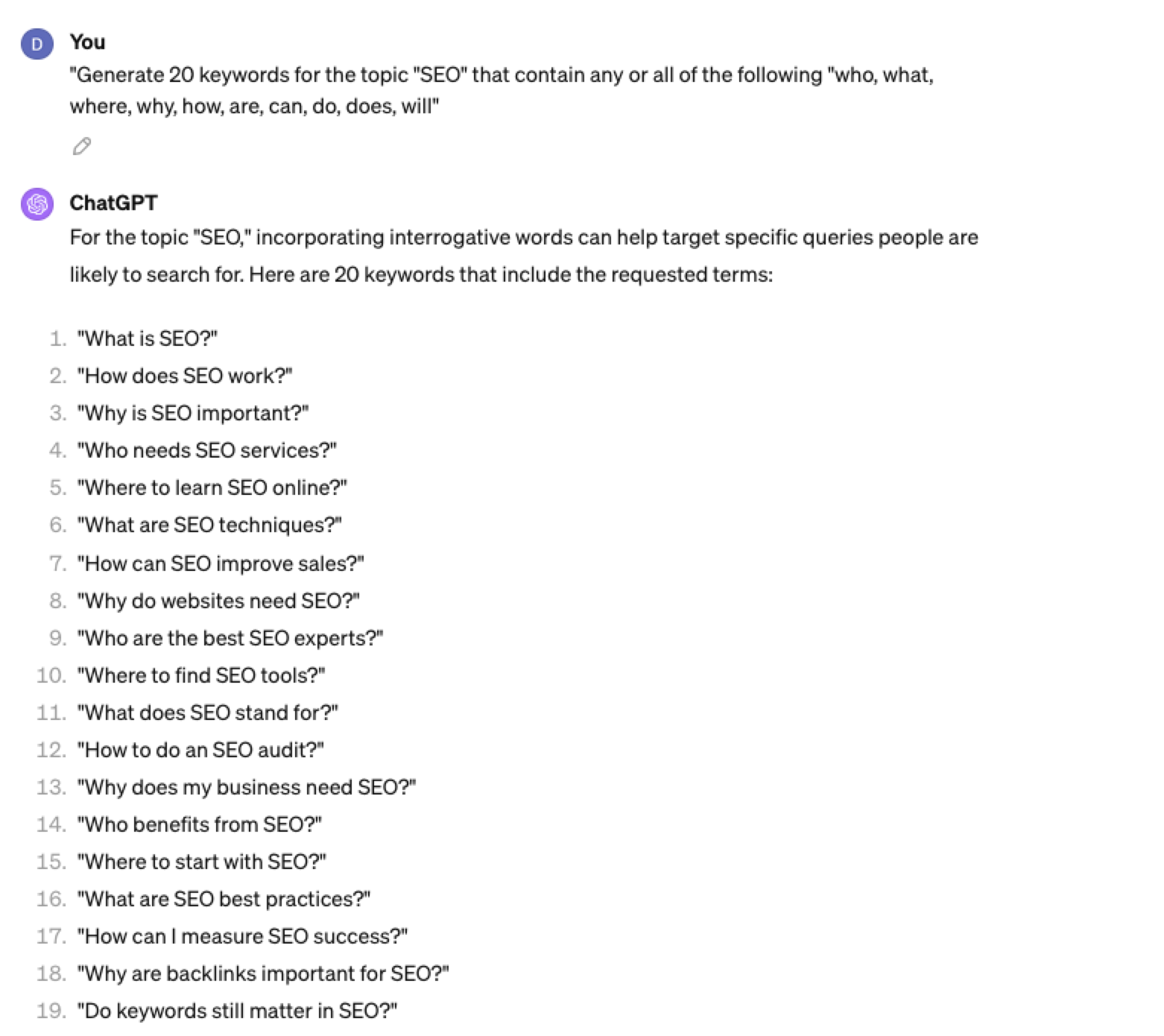 Screenshot ChatGPT 4, April 2024
Screenshot ChatGPT 4, April 20242. Comparison Patterns
Example:
“Generate 50 keywords for the topic “{Topic}” that contain any or all of the following “for, vs, alternative, best, top, review”
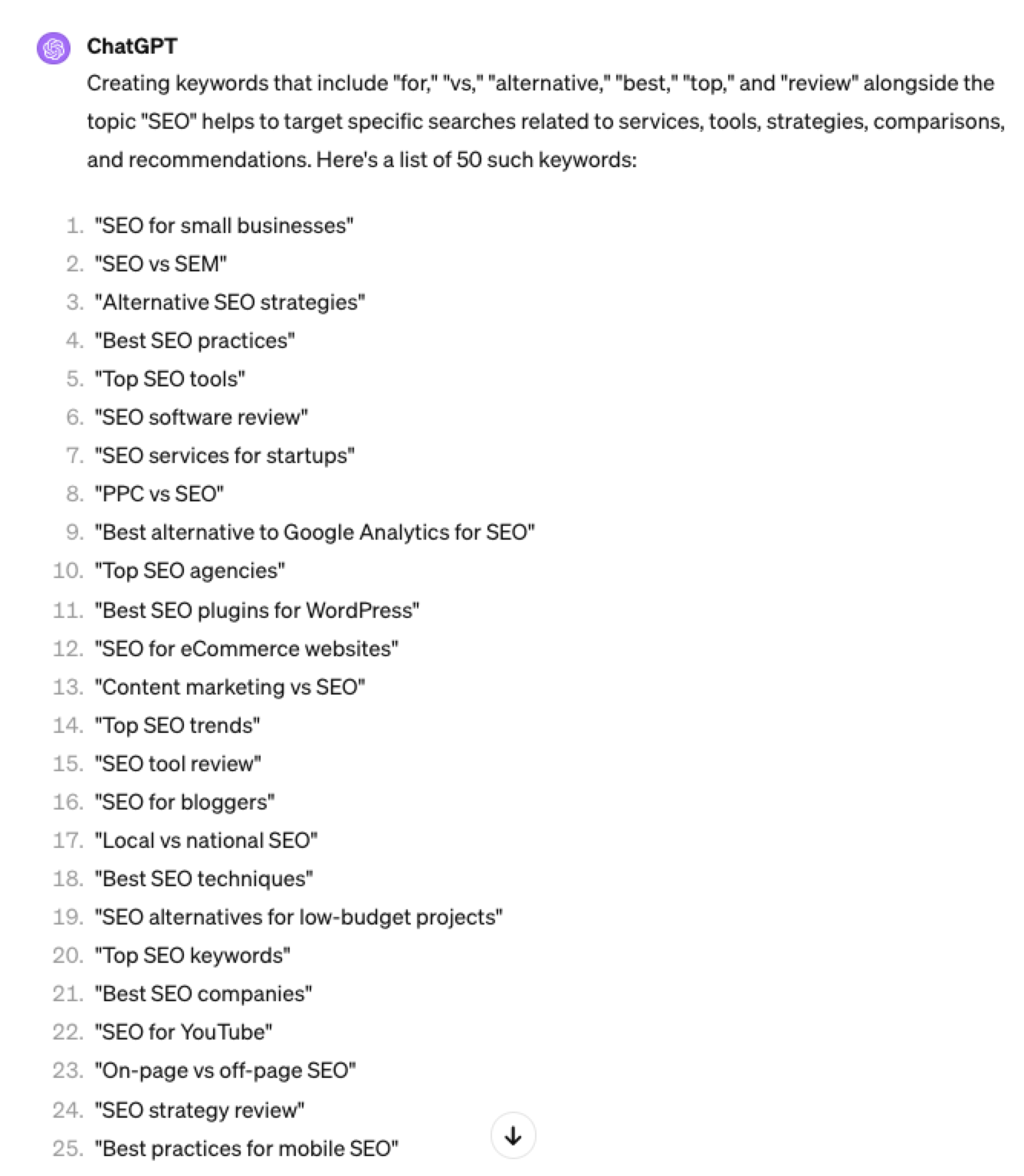 Screenshot ChatGPT 4, April 2024
Screenshot ChatGPT 4, April 20243. Brand Patterns
Another one of my favorite modifiers is a keyword by brand.
We are probably all familiar with the most popular SEO brands; however, if you aren’t, you could ask your AI friend to do the heavy lifting.
Example prompt:
“For the top {Topic} brands what are the top “vs” keywords”
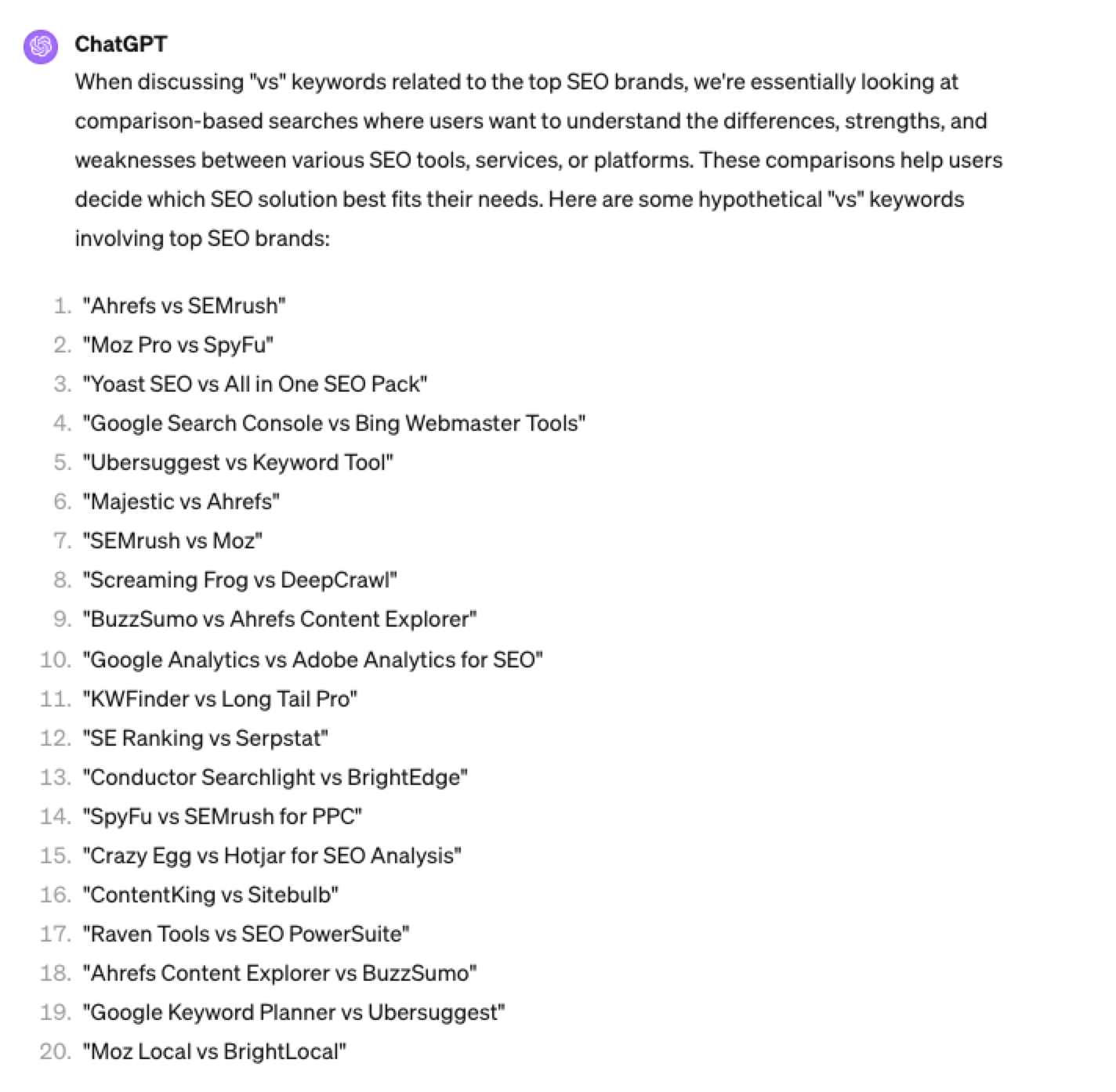 Screenshot ChatGPT 4, April 2024
Screenshot ChatGPT 4, April 20244. Search Intent Patterns
One of the most common search intent patterns is “best.”
When someone is searching for a “best {topic}” keyword, they are generally searching for a comprehensive list or guide that highlights the top options, products, or services within that specific topic, along with their features, benefits, and potential drawbacks, to make an informed decision.
Example:
“For the topic of “[Topic]” what are the 20 top keywords that include “best”
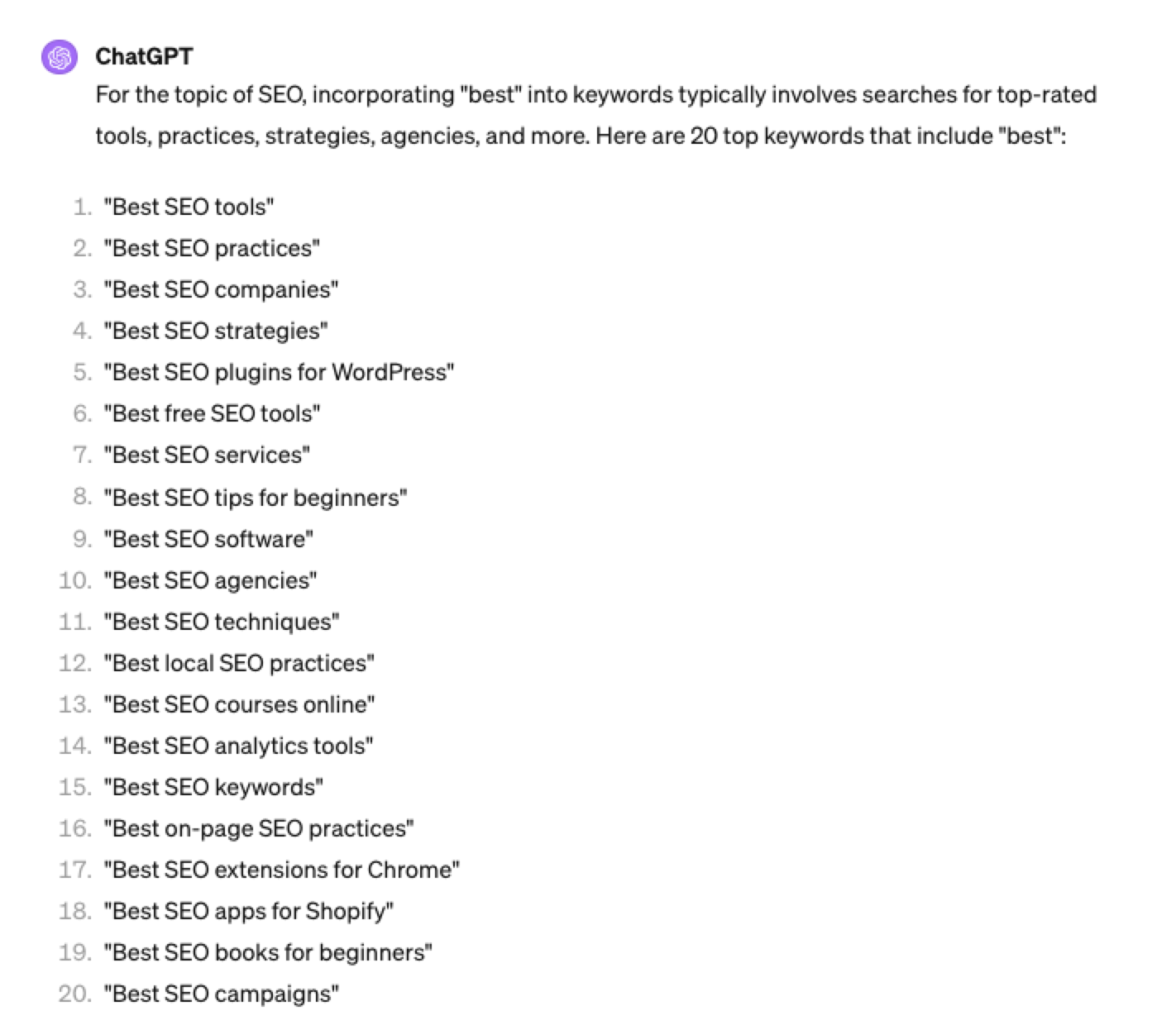 Screenshot ChatGPT 4, April 2024
Screenshot ChatGPT 4, April 2024Again, this guide to keyword research using ChatGPT has emphasized the ease of generating keyword research ideas by utilizing ChatGPT throughout the process.
Keyword Research Using ChatGPT Vs. Keyword Research Tools
Free Vs. Paid Keyword Research Tools
Like keyword research tools, ChatGPT has free and paid options.
However, one of the most significant drawbacks of using ChatGPT for keyword research alone is the absence of SEO metrics to help you make smarter decisions.
To improve accuracy, you could take the results it gives you and verify them with your classic keyword research tool – or vice versa, as shown above, uploading accurate data into the tool and then prompting.
However, you must consider how long it takes to type and fine-tune your prompt to get your desired data versus using the filters within popular keyword research tools.
For example, if we use a popular keyword research tool using filters, you could have all of the “best” queries with all of their SEO metrics:
-
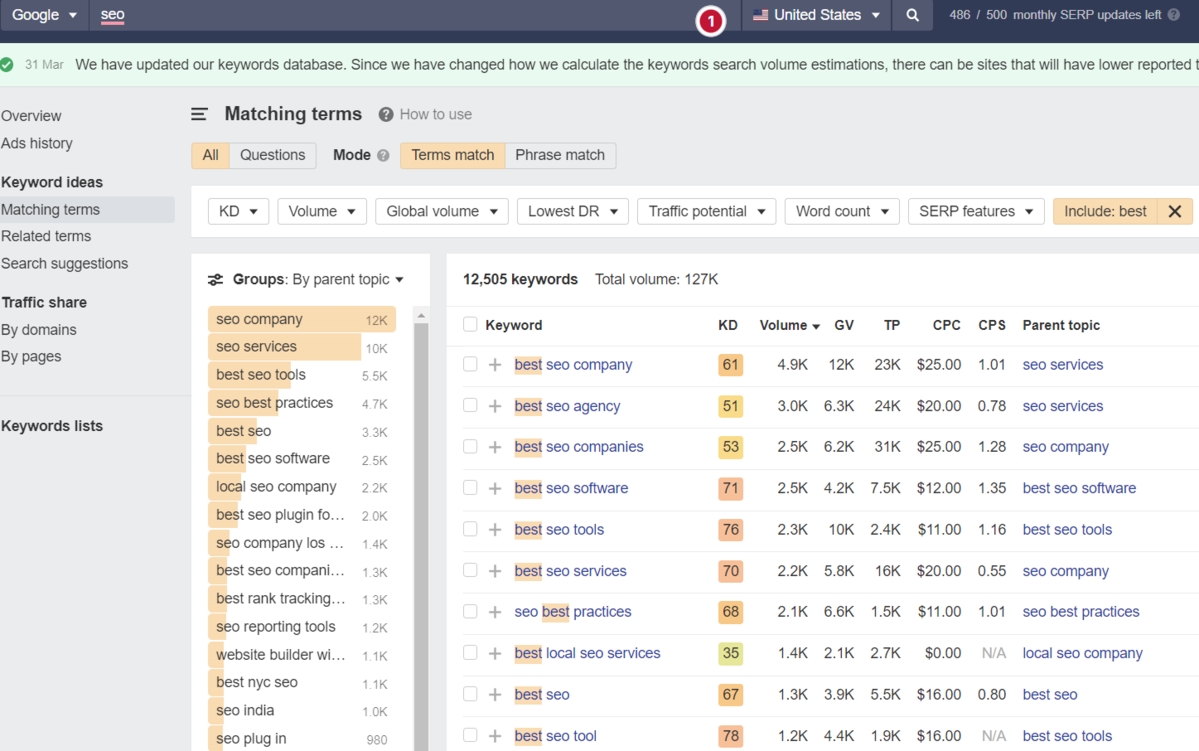 Screenshot from Ahrefs Keyword Explorer, March 2024
Screenshot from Ahrefs Keyword Explorer, March 2024
And unlike ChatGPT, generally, there is no token limit; you can extract several hundred, if not thousands, of keywords at a time.
As I have mentioned multiple times throughout this piece, you cannot blindly trust the data or SEO metrics it may attempt to provide you with.
The key is to validate the keyword research with a keyword research tool.
ChatGPT For International SEO Keyword Research
ChatGPT can be a terrific multilingual keyword research assistant.
For example, if you wanted to research keywords in a foreign language such as French. You could ask ChatGPT to translate your English keywords;
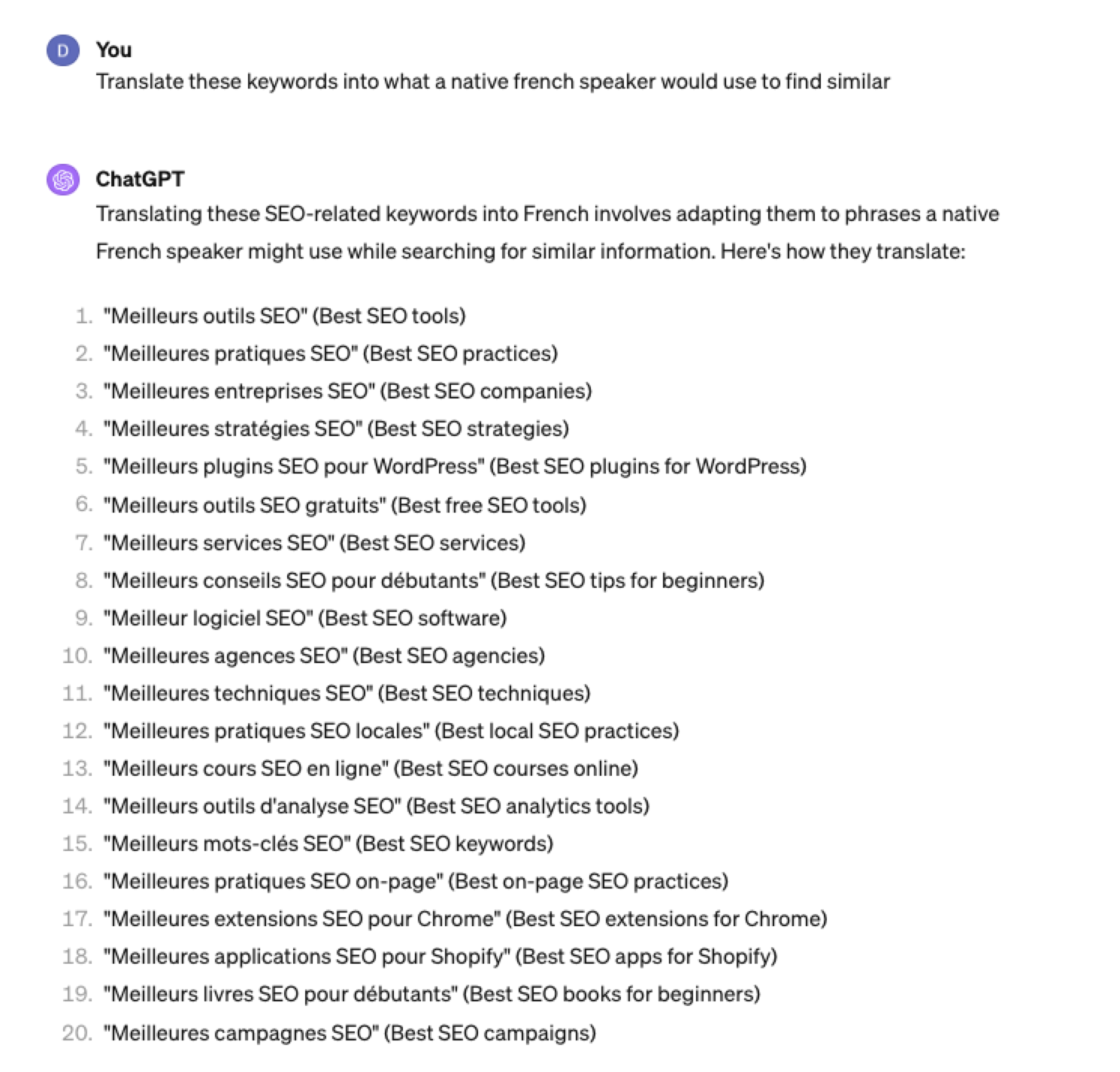 Screenshot ChatGPT 4, Apil 2024
Screenshot ChatGPT 4, Apil 2024- The key is to take the data above and paste it into a popular keyword research tool to verify.
- As you can see below, many of the keyword translations for the English keywords do not have any search volume for direct translations in French.
 Screenshot from Ahrefs Keyword Explorer, April 2024
Screenshot from Ahrefs Keyword Explorer, April 2024But don’t worry, there is a workaround: If you have access to a competitor keyword research tool, you can see what webpage is ranking for that query – and then identify the top keyword for that page based on the ChatGPT translated keywords that do have search volume.
-
-
 Screenshot from Ahrefs Keyword Explorer, April 2024
Screenshot from Ahrefs Keyword Explorer, April 2024
Or, if you don’t have access to a paid keyword research tool, you could always take the top-performing result, extract the page copy, and then ask ChatGPT what the primary keyword for the page is.
Key Takeaway
-
ChatGPT can be an expert on any topic and an invaluable keyword research tool. However, it is another tool to add to your toolbox when doing keyword research; it does not replace traditional keyword research tools.
As shown throughout this tutorial, from making up keywords at the beginning to inaccuracies around data and translations, ChatGPT can make mistakes when used for keyword research.
You cannot blindly trust the data you get back from ChatGPT.
However, it can offer a shortcut to understanding any topic for which you need to do keyword research and, as a result, save you countless hours.
But the key is how you prompt.
The prompts I shared with you above will help you understand a topic in minutes instead of hours and allow you to better seed keywords using keyword research tools.
It can even replace mundane keyword clustering tasks that you used to do with formulas in spreadsheets or generate ideas based on keywords you give it.
Paired with traditional keyword research tools, ChatGPT for keyword research can be a powerful tool in your arsenal.
More resources:
Featured Image: Tatiana Shepeleva/Shutterstock
SEO
OpenAI Expected to Integrate Real-Time Data In ChatGPT

Sam Altman, CEO of OpenAI, dispelled rumors that a new search engine would be announced on Monday, May 13. Recent deals have raised the expectation that OpenAI will announce the integration of real-time content from English, Spanish, and French publications into ChatGPT, complete with links to the original sources.
OpenAI Search Is Not Happening
Many competing search engines have tried and failed to challenge Google as the leading search engine. A new wave of hybrid generative AI search engines is currently trying to knock Google from the top spot with arguably very little success.
Sam Altman is on record saying that creating a search engine to compete against Google is not a viable approach. He suggested that technological disruption was the way to replace Google by changing the search paradigm altogether. The speculation that Altman is going to announce a me-too search engine on Monday never made sense given his recent history of dismissing the concept as a non-starter.
So perhaps it’s not a surprise that he recently ended the speculation by explicitly saying that he will not be announcing a search engine on Monday.
He tweeted:
“not gpt-5, not a search engine, but we’ve been hard at work on some new stuff we think people will love! feels like magic to me.”
“New Stuff” May Be Iterative Improvement
It’s quite likely that what’s going to be announced is iterative which means it improves ChatGPT but not replaces it. This fits into how Altman recently expressed his approach with ChatGPT.
He remarked:
“And it does kind of suck to ship a product that you’re embarrassed about, but it’s much better than the alternative. And in this case in particular, where I think we really owe it to society to deploy iteratively.
There could totally be things in the future that would change where we think iterative deployment isn’t such a good strategy, but it does feel like the current best approach that we have and I think we’ve gained a lot from from doing this and… hopefully the larger world has gained something too.”
Improving ChatGPT iteratively is Sam Altman’s preference and recent clues point to what those changes may be.
Recent Deals Contain Clues
OpenAI has been making deals with news media and User Generated Content publishers since December 2023. Mainstream media has reported these deals as being about licensing content for training large language models. But they overlooked a a key detail that we reported on last month which is that these deals give OpenAI access to real-time information that they stated will be used to give attribution to that real-time data in the form of links.
That means that ChatGPT users will gain the ability to access real-time news and to use that information creatively within ChatGPT.
Dotdash Meredith Deal
Dotdash Meredith (DDM) is the publisher of big brand publications such as Better Homes & Gardens, FOOD & WINE, InStyle, Investopedia, and People magazine. The deal that was announced goes way beyond using the content as training data. The deal is explicitly about surfacing the Dotdash Meredith content itself in ChatGPT.
The announcement stated:
“As part of the agreement, OpenAI will display content and links attributed to DDM in relevant ChatGPT responses. …This deal is a testament to the great work OpenAI is doing on both fronts to partner with creators and publishers and ensure a healthy Internet for the future.
Over 200 million Americans each month trust our content to help them make decisions, solve problems, find inspiration, and live fuller lives. This partnership delivers the best, most relevant content right to the heart of ChatGPT.”
A statement from OpenAI gives credibility to the speculation that OpenAI intends to directly show licensed third-party content as part of ChatGPT answers.
OpenAI explained:
“We’re thrilled to partner with Dotdash Meredith to bring its trusted brands to ChatGPT and to explore new approaches in advancing the publishing and marketing industries.”
Something that DDM also gets out of this deal is that OpenAI will enhance DDM’s in-house ad targeting in order show more tightly focused contextual advertising.
Le Monde And Prisa Media Deals
In March 2024 OpenAI announced a deal with two global media companies, Le Monde and Prisa Media. Le Monde is a French news publication and Prisa Media is a Spanish language multimedia company. The interesting aspects of these two deals is that it gives OpenAI access to real-time data in French and Spanish.
Prisa Media is a global Spanish language media company based in Madrid, Spain that is comprised of magazines, newspapers, podcasts, radio stations, and television networks. It’s reach extends from Spain to America. American media companies include publications in the United States, Argentina, Bolivia, Chile, Colombia, Costa Rica, Ecuador, Mexico, and Panama. That is a massive amount of real-time information in addition to a massive audience of millions.
OpenAI explicitly announced that the purpose of this deal was to bring this content directly to ChatGPT users.
The announcement explained:
“We are continually making improvements to ChatGPT and are supporting the essential role of the news industry in delivering real-time, authoritative information to users. …Our partnerships will enable ChatGPT users to engage with Le Monde and Prisa Media’s high-quality content on recent events in ChatGPT, and their content will also contribute to the training of our models.”
That deal is not just about training data. It’s about bringing current events data to ChatGPT users.
The announcement elaborated in more detail:
“…our goal is to enable ChatGPT users around the world to connect with the news in new ways that are interactive and insightful.”
As noted in our April 30th article that revealed that OpenAI will show links in ChatGPT, OpenAI intends to show third party content with links to that content.
OpenAI commented on the purpose of the Le Monde and Prisa Media partnership:
“Over the coming months, ChatGPT users will be able to interact with relevant news content from these publishers through select summaries with attribution and enhanced links to the original articles, giving users the ability to access additional information or related articles from their news sites.”
There are additional deals with other groups like The Financial Times which also stress that this deal will result in a new ChatGPT feature that will allow users to interact with real-time news and current events .
OpenAI’s Monday May 13 Announcement
There are many clues that the announcement on Monday will be that ChatGPT users will gain the ability to interact with content about current events. This fits into the terms of recent deals with news media organizations. There may be other features announced as well but this part is something that there are many clues pointing to.
Watch Altman’s interview at Stanford University
Featured Image by Shutterstock/photosince
SEO
Google’s Strategies For Dealing With Content Decay

In the latest episode of the Search Off The Record podcast, Google Search Relations team members John Mueller and Lizzi Sassman did a deep dive into dealing with “content decay” on websites.
Outdated content is a natural issue all sites face over time, and Google has outlined strategies beyond just deleting old pages.
While removing stale content is sometimes necessary, Google recommends taking an intentional, format-specific approach to tackling content decay.
Archiving vs. Transitional Guides
Google advises against immediately removing content that becomes obsolete, like materials referencing discontinued products or services.
Removing content too soon could confuse readers and lead to a poor experience, Sassman explains:
“So, if I’m trying to find out like what happened, I almost need that first thing to know. Like, “What happened to you?” And, otherwise, it feels almost like an error. Like, “Did I click a wrong link or they redirect to the wrong thing?””
Sassman says you can avoid confusion by providing transitional “explainer” pages during deprecation periods.
A temporary transition guide informs readers of the outdated content while steering them toward updated resources.
Sassman continues:
“That could be like an intermediary step where maybe you don’t do that forever, but you do it during the transition period where, for like six months, you have them go funnel them to the explanation, and then after that, all right, call it a day. Like enough people know about it. Enough time has passed. We can just redirect right to the thing and people aren’t as confused anymore.”
When To Update Vs. When To Write New Content
For reference guides and content that provide authoritative overviews, Google suggests updating information to maintain accuracy and relevance.
However, for archival purposes, major updates may warrant creating a new piece instead of editing the original.
Sassman explains:
“I still want to retain the original piece of content as it was, in case we need to look back or refer to it, and to change it or rehabilitate it into a new thing would almost be worth republishing as a new blog post if we had that much additional things to say about it.”
Remove Potentially Harmful Content
Google recommends removing pages in cases where the outdated information is potentially harmful.
Sassman says she arrived at this conclusion when deciding what to do with a guide involving obsolete structured data:
“I think something that we deleted recently was the “How to Structure Data” documentation page, which I thought we should just get rid of it… it almost felt like that’s going to be more confusing to leave it up for a period of time.
And actually it would be negative if people are still adding markup, thinking they’re going to get something. So what we ended up doing was just delete the page and redirect to the changelog entry so that, if people clicked “How To Structure Data” still, if there was a link somewhere, they could still find out what happened to that feature.”
Internal Auditing Processes
To keep your content current, Google advises implementing a system for auditing aging content and flagging it for review.
Sassman says she sets automated alerts for pages that haven’t been checked in set periods:
“Oh, so we have a little robot to come and remind us, “Hey, you should come investigate this documentation page. It’s been x amount of time. Please come and look at it again to make sure that all of your links are still up to date, that it’s still fresh.””
Context Is Key
Google’s tips for dealing with content decay center around understanding the context of outdated materials.
You want to prevent visitors from stumbling across obsolete pages without clarity.
Additional Google-recommended tactics include:
- Prominent banners or notices clarifying a page’s dated nature
- Listing original publish dates
- Providing inline annotations explaining how older references or screenshots may be obsolete
How This Can Help You
Following Google’s recommendations for tackling content decay can benefit you in several ways:
- Improved user experience: By providing clear explanations, transition guides, and redirects, you can ensure that visitors don’t encounter confusing or broken pages.
- Maintained trust and credibility: Removing potentially harmful or inaccurate content and keeping your information up-to-date demonstrates your commitment to providing reliable and trustworthy resources.
- Better SEO: Regularly auditing and updating your pages can benefit your website’s search rankings and visibility.
- Archival purposes: By creating new content instead of editing older pieces, you can maintain a historical record of your website’s evolution.
- Streamlined content management: Implementing internal auditing processes makes it easier to identify and address outdated or problematic pages.
By proactively tackling content decay, you can keep your website a valuable resource, improve SEO, and maintain an organized content library.
Listen to the full episode of Google’s podcast below:
Featured Image: Stokkete/Shutterstock
-

 PPC5 days ago
PPC5 days agoHow the TikTok Algorithm Works in 2024 (+9 Ways to Go Viral)
-

 MARKETING7 days ago
MARKETING7 days agoA Recap of Everything Marketers & Advertisers Need to Know
-

 SEO6 days ago
SEO6 days agoBlog Post Checklist: Check All Prior to Hitting “Publish”
-

 SEO4 days ago
SEO4 days agoHow to Use Keywords for SEO: The Complete Beginner’s Guide
-

 MARKETING5 days ago
MARKETING5 days agoHow To Protect Your People and Brand
-

 SEARCHENGINES6 days ago
SEARCHENGINES6 days agoGoogle Started Enforcing The Site Reputation Abuse Policy
-

 PPC6 days ago
PPC6 days agoHow to Craft Compelling Google Ads for eCommerce
-

 MARKETING6 days ago
MARKETING6 days agoElevating Women in SEO for a More Inclusive Industry








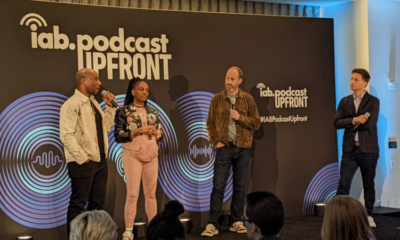





You must be logged in to post a comment Login